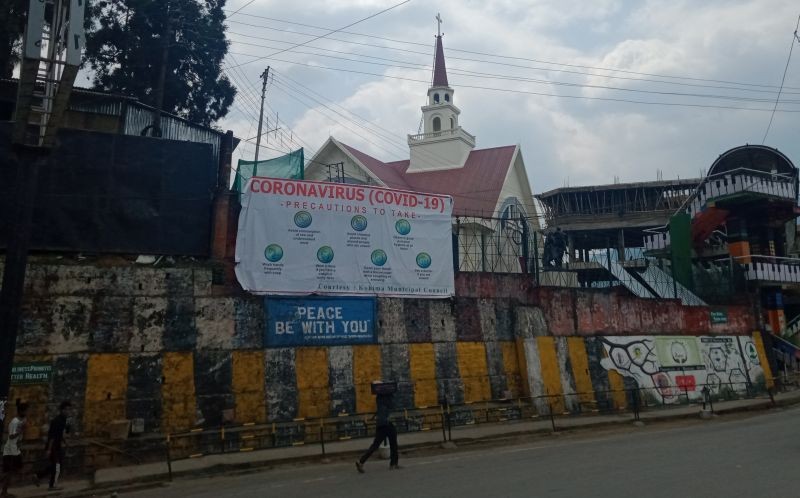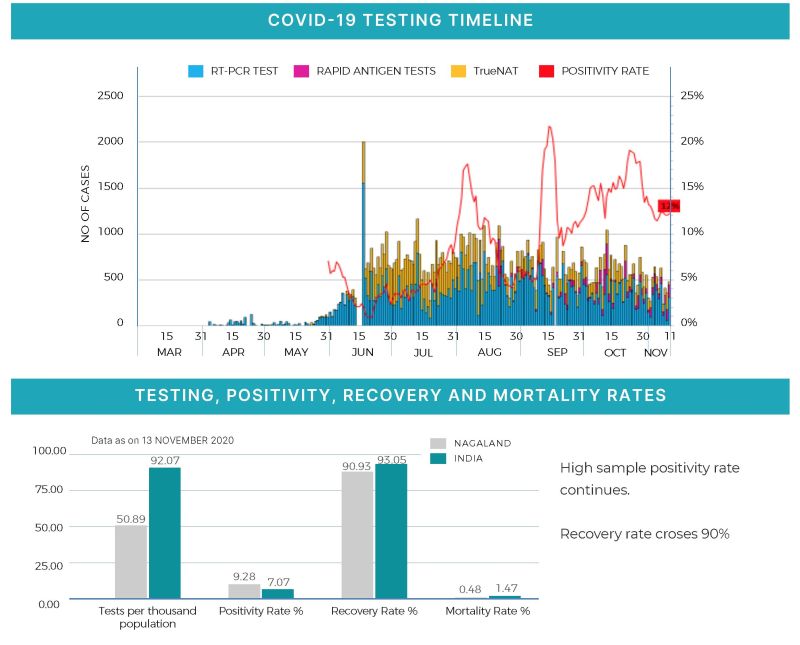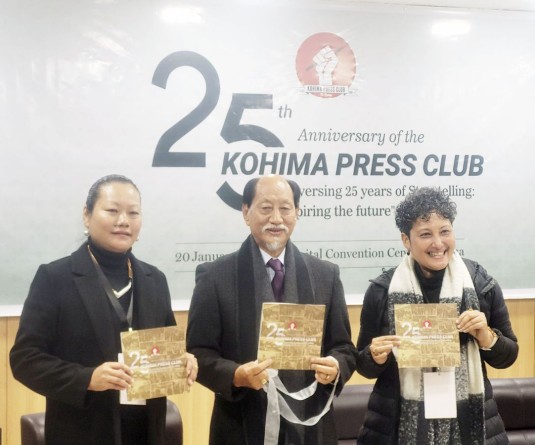A banner displaying precautionary measures against COVID-19 near Old MLA Hostel Junction, Kohima. (Morung File Photo | For representational purpose only)

311 cases reported during the week at 11 percent positivity rate
Morung Express News
Dimapur | November 14
Nagaland reported 311 COVID-19 cases during the week (November 7-13). It included 198 traced contacts, 75 armed forces personnel, 25 returnees/travelers and 13 frontline workers. The state also reported 7 deaths during the week, taking the death toll for the month so far to 12.
The state continued to report relatively low number cases over the past 4 weeks. However, the latest weekly COVID roundup issued by the state Integrated Disease Surveillance Programme (IDSP), Health & Family Welfare, on November 14, pointed to a consistently high sample positivity rate, increasing number of symptomatic cases and more frequent instances of infection in households and workplaces.
“Sample positivity rate remains very high which could mean more undetected cases in the community,” the report emphasized, while adding the overall sample positivity rate of 9.3 percent continues to be higher than the national average of 7 percent. 
The week’s positivity rate worked out to 11 percent of 2919 samples, dropping from 12 percent previously. The positivity rate for November 14 worked out to 35.7 percent or 112 positive results out of 313 samples tested.
The positivity rate in Dimapur stood at 12.4 percent, while in Kohima, it was 9.7 percent. In Peren, Zunheboto and Mon, it worked out to 7.5 percent, 7 percent and 5.1 percent, respectively. The other affected districts were below 5 percent.
It added that the positivity rate among household contacts was 31 percent (1039/3389), higher than the than the office goers’ 24 percent (801/3389).
The positivity rate among the students continued to remain steady at 18 percent, while it noted that rising detection among people coming to flu clinics for check-ups (for travel purposes or pre-op screening) “is worrisome.”
The IDSP, in its weekly report, stated that people with no known travel history or exposure to confirmed cases have tested positive.
As on November 14, Nagaland has tested a cumulative 1,04,157 samples.
Delay and deaths
Reluctance and delay in seeking medical help inspite of telltale symptoms was pointed out as a serious concern with the IDSP stating that 36 percent of deaths have happened within 48 hours of reporting to the hospital. While stating that it signifies “late arrival to the hospital with very advanced symptoms,” it reminded, “The key is early and timely intervention of the limited treatments available.”
63 percent of all deaths have been below 60 years of age with 24-40 years (28 percent) as the most affected age group. As reported earlier, diabetes and hypertension happened to be the most commonly associated co-morbidities with 78 percent of the deaths linked to pre-existing health conditions.
Cases with comorbidity increased to 1 percent from 0.4 percent in the last two months along with a 1 percent increase in the 60 plus age group “signifying an epidemiological shift to the high-risk groups.”
Meanwhile, the mortality rate increased to 0.48 percent from 0.42 percent previously. Comparatively, the country’s mortality rate was hovering at 1.47 percent.
Rising symptomatic & traced contacts
Symptomatic cases have increased to 5 percent from 0.7 percent. According to the report, fever (78 percent) and cough (52 percent) have been the most commonly reported symptoms.
As on November 14, positive traced contacts made up 3449 or 29 percent of the statewide tally of 9750 cases. The report said that household and workplaces have been the most common places of infection among traced contacts, adding, “Among the traced contacts, the most affected age group is 21-30 years at 26 percent and 31-40 years at 26 percent. Among them, 63 percent (2132/3389) are males. This further endangers the high-risk groups.”
“The uncontrolled spread among the age group of 21-40 years is increasing risk in the higher age groups,” it maintained.
Recovery & testing rate
The recovery rate has crossed 90 percent, almost at par with the national average of 93 percent.
Improving recovery rate was however overshadowed by low testing and high positivity rate. Nagaland made no improvement from the 50.1 test per thousand population of the previous week, with this week’s testing rate tipped at 50.8 per thousand population against the national average of 92.07 per thousand.
Case distribution
Overall, the armed forces/security personnel, including the police, have reported the most number of cases in the state, at 45 percent or 4099 of the statewide total, as on November 14. The tally of positive traced contacts increased to 3449 from the previous week’s 3245 or 29 percent of the state total. Returnees’ case count increased to 1730 or 21 percent, while the tally of frontline workers increased to 472 cases or 5 percent.
The median age of the positive cases worked out to 32 years with the youngest being a one-month old infant and the oldest being a 98 year-old. 80 percent of the cases have been male.





